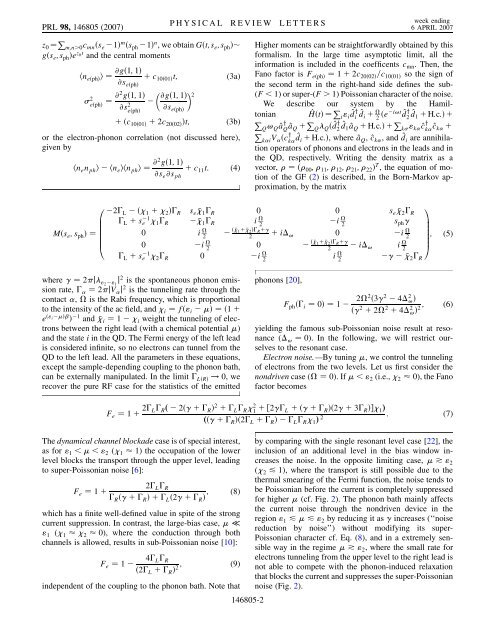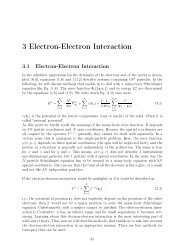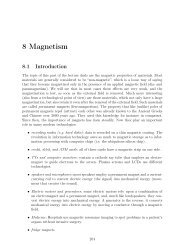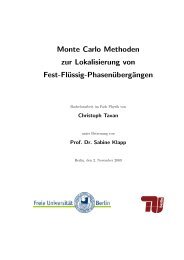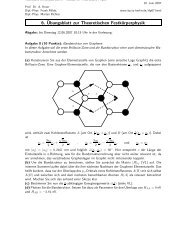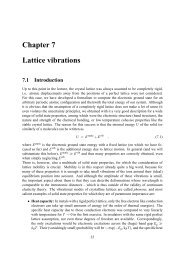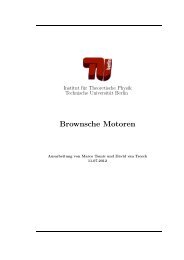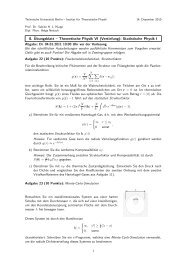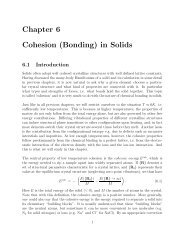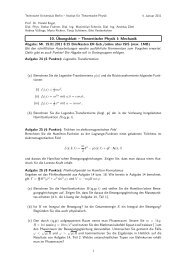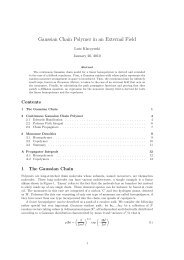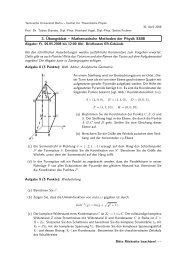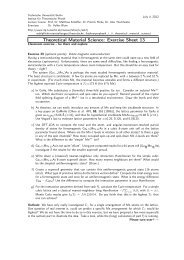Resonance Fluorescence in Transport through Quantum Dots ...
Resonance Fluorescence in Transport through Quantum Dots ...
Resonance Fluorescence in Transport through Quantum Dots ...
You also want an ePaper? Increase the reach of your titles
YUMPU automatically turns print PDFs into web optimized ePapers that Google loves.
PRL 98, 146805 (2007)<br />
PHYSICAL REVIEW LETTERS week end<strong>in</strong>g<br />
6 APRIL 2007<br />
z 0<br />
Pm;n>0c mn s e 1 m s ph 1 n , we obta<strong>in</strong> G t;s e ;s ph<br />
g s e ;s ph e z 0t and the central moments<br />
hn e ph i<br />
2<br />
e ph<br />
@g 1; 1<br />
@s e ph<br />
c 10 01 t; (3a)<br />
@ 2 g 1; 1<br />
@s 2 e ph<br />
@g 1; 1<br />
@s e ph<br />
2<br />
c 10 01 2c 20 02 t; (3b)<br />
or the electron-phonon correlation (not discussed here),<br />
given by<br />
hn e n ph i<br />
hn e ihn ph i<br />
@ 2 g 1; 1<br />
@s e @s ph<br />
c 11 t: (4)<br />
Higher moments can be straightforwardly obta<strong>in</strong>ed by this<br />
formalism. In the large time asymptotic limit, all the<br />
<strong>in</strong>formation is <strong>in</strong>cluded <strong>in</strong> the coefficents c mn . Then, the<br />
Fano factor is F e ph 1 2c 20 02 =c 10 01 so the sign of<br />
the second term <strong>in</strong> the right-hand side def<strong>in</strong>es the sub-<br />
(F1) Poissonian character of the noise.<br />
We describe our system by the Hamiltonian<br />
^H t i" i ^d y i<br />
P<br />
^d i 2 e i!t ^d y ^d 2 1 H:c:<br />
P<br />
Q! Q ^a y Q ^a P ^d Q Q Q y ^d P<br />
2 1 ^a Q H:c: k " k ^c y k ^c k<br />
P<br />
k iV c y k<br />
^d i H:c: , where ^a Q , ^c k , and ^d i are annihilation<br />
operators of phonons and electrons <strong>in</strong> the leads and <strong>in</strong><br />
the QD, respectively. Writ<strong>in</strong>g the density matrix as a<br />
vector, 00; 11; 12; 21; 22 T , the equation of motion<br />
of the GF (2) is described, <strong>in</strong> the Born-Markov approximation,<br />
by the matrix<br />
0<br />
2 L 1 2 R s e 1 R 0 0 s<br />
1<br />
e 2 R<br />
L se 1 1 R 1 R i 2<br />
i 2<br />
s ph<br />
1 2 R<br />
M s e ;s ph 0 i 2 2<br />
i ! 0 i 2<br />
B<br />
@<br />
C<br />
; (5)<br />
1 2 R<br />
0 i 2<br />
0<br />
2<br />
i ! i 2<br />
A<br />
L se 1 2 R 0 i 2<br />
i 2 2 R<br />
where 2 j " 2 " 1<br />
j 2 is the spontaneous phonon emission<br />
rate, 2 jV j 2 is the tunnel<strong>in</strong>g rate <strong>through</strong> the<br />
contact , is the Rabi frequency, which is proportional<br />
to the <strong>in</strong>tensity of the ac field, and i f " i 1<br />
e " i 1 and i 1 i weight the tunnel<strong>in</strong>g of electrons<br />
between the right lead (with a chemical potential )<br />
and the state i <strong>in</strong> the QD. The Fermi energy of the left lead<br />
is considered <strong>in</strong>f<strong>in</strong>ite, so no electrons can tunnel from the<br />
QD to the left lead. All the parameters <strong>in</strong> these equations,<br />
except the sample-depend<strong>in</strong>g coupl<strong>in</strong>g to the phonon bath,<br />
can be externally manipulated. In the limit L R ! 0, we<br />
recover the pure RF case for the statistics of the emitted<br />
phonons [20],<br />
F ph i 0 1<br />
2 2 3 2 4 2 !<br />
2<br />
2 2 4 2 ! 2 ; (6)<br />
yield<strong>in</strong>g the famous sub-Poissonian noise result at resonance<br />
( ! 0). In the follow<strong>in</strong>g, we will restrict ourselves<br />
to the resonant case.<br />
Electron noise.—By tun<strong>in</strong>g , we control the tunnel<strong>in</strong>g<br />
of electrons from the two levels. Let us first consider the<br />
nondriven case ( 0). If


